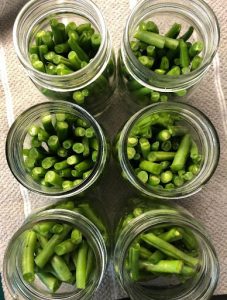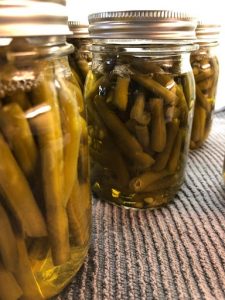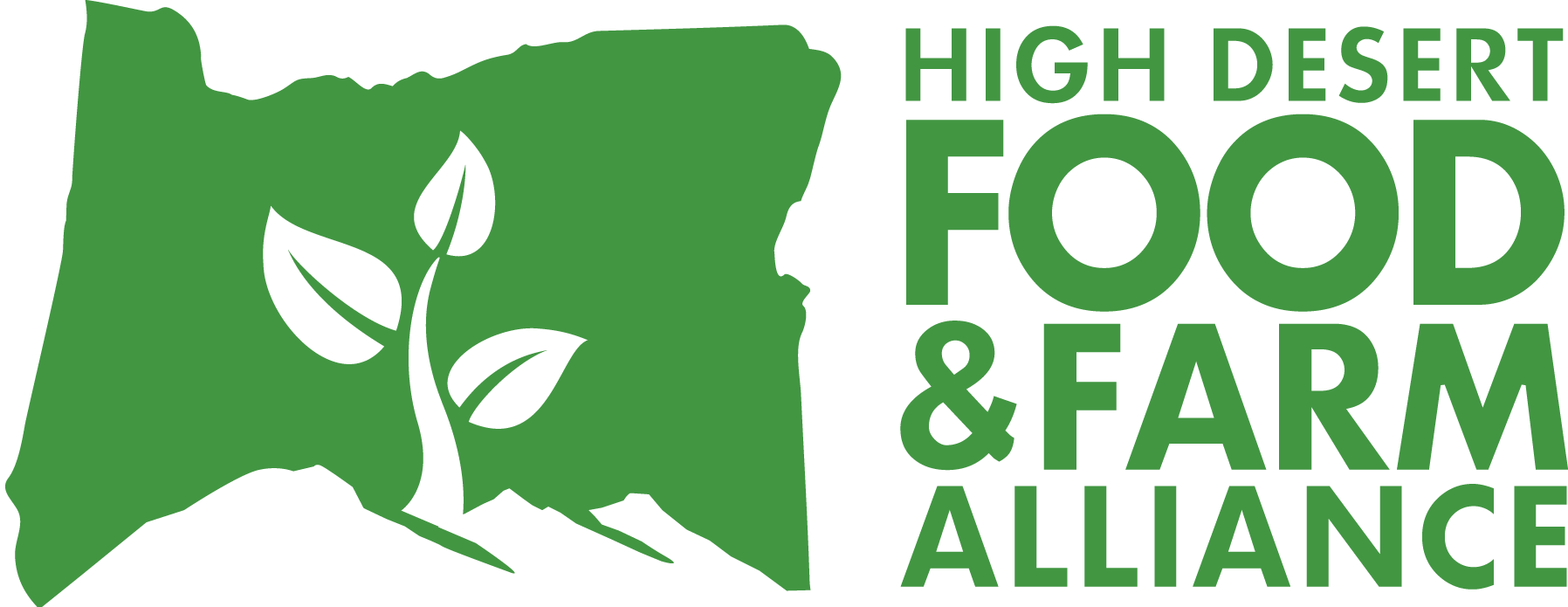This is the 7th blog post in a series about food preservation by HDFFA guest blogger, Mary Lowe. Mary has been a certified Master Food Preserver volunteer with Oregon State University Extension for 10 years and will be sharing up-to-date, research-based information and tips for safe food preservation at home. Happy preserving!
PRESSURE CANNING – YOU CAN DO IT!

Green beans in the pantry with pickles, jams and preserves.
My goodness it was cold this morning in Central Oregon. For the first time in 2 months, instead of wearing shorts and a t-shirt, I’m in full length jeans and a sweater. I think fall is coming. But, the gardens are not finished producing and the farmers markets and produce stands are still offering mountains of fresh and nutritious vegetables. So, let’s talk about preserving some of those veggies. Whether you dry, freeze, pickle or can them, it’s time to get busy. Preserve it now while the sun is shining and there’s an abundance so you can eat it later when there’s snow on the ground.
I’ve already written a little bit in this blog about drying, freezing and pickling. While there’s always more to say on those subjects, now I want to talk about pressure canning some vegetables. Is there a look of horror and fear on your face? Is your heart beating a little bit faster? You’re not alone. I often hear from people that they are afraid of some aspects of canning. Especially pressure canning. I too used to be fearful of pressure canning. Now, I am informed and experienced. I approach pressure canning with a can do attitude, confidence and with up-to-date publications and recipes in hand from reliable sources.
I like to get into the Zen of food preservation before I start the process. I clean my kitchen. Put extraneous stuff away. Lay out all the equipment and ingredients I will need. Put out a stack of clean kitchen towels. Open the recipe book. I smile and take a deep breath, or several. (Then I usually get interrupted by my husband or a text or phone call. Oh well.) Take another deep breath and begin.
SOME FOOD SCIENCE
 Food preservation is a science. Don’t run, please come back and listen for just a minute. It’s a fun and delicious science, but it is science. With the right equipment and information, you can do it.
Food preservation is a science. Don’t run, please come back and listen for just a minute. It’s a fun and delicious science, but it is science. With the right equipment and information, you can do it.
“The acidity of a food is very important in food preservation. Pathogenic bacteria, particularly Clostridium botulinum, do not grow when the pH is 4.6 or below. Foods that have a pH of 4.6 or lower are called high-acid foods and include most fruits, most tomatoes and pickles. Low-acid foods have a pH above 4.6. They include meats, poultry, fish and vegetables.” (Oregon State University Extension Service publication SP 50-1001)
High-acid foods can either be canned using the water bath method or pressure canned. Low-acid foods must be pressure canned. The combination of heat and pressure kills pathogens that may be present and creates a seal that prevents any contamination. Here’s more information about pH and canning methods.
PRESSURE CANNING EQUIPMENT
Investing in a new pressure canner from a reputable company is a good investment. All the parts are there and they are in good working order. The manufacturer also includes a nice, simple little book explaining how to operate the pressure canner. Recipes may be included but you should not rely upon them. Updates can occur due to new information or testing with new technology. If a good pressure canner and the instruction booklet and a recipe from a reliable source, that’s probably all you need to proceed.
If you have an older pressure canner, make sure the seal is still pliable with no cracks or missing pieces. It is safest not to use old equipment that may have been purchased at a yard sale or passed down from an older relative. These may not be in good working order or do not use current design and manufacturing technology. The National Center for Home Food Preparation has a pressure canner inspection checklist to help you determine whether an experienced pressure canner can still be used. https://nchfp.uga.edu/educators/PressureCannerInspect21.Final.pdf
If you have an All-American canner with a toggle switch on the vent port, the company recommends you purchase parts to convert it to a weighted gauge canner. See their web page for the parts list.
If you have a Presto dial gauge pressure canner, you should have the gauge tested when it is purchased and at the beginning of each canning season. This service is usually available through the OSU Extension Service office.
Beware of false advertising. OSU Extension and the NCHFP do not recommend any electric pressure canners at this time. Electric pressure cookers are great for making dinner, but cannot be guaranteed for a safe product.


Left – Weighted Gauge Pressure Canner, Right – Dial Gauge Pressure Canner

My filled jars ready for liquid, lids and rings.
LET’S DO IT
I pressure-canned a small batch of green beans to use as an example for this writing. I washed them, cut off ends and pulled off any strings. Then I cut some of them into one inch pieces and others I cut to 4” to fit the height of the pint jars. Either size works great, it’s your preference. Also, I left a 1” headspace when packing and filling my jars. That is the recommended measurement that leaves room for product expansion during processing.
For a good start on pressure canning, please read the information and follow along with the instructions in Canning Vegetables, PNW 172 from OSU Extension. OSU Extension has adapted the recipes from the NCHFP to be more user friendly for food preservation enthusiasts in the Pacific Northwest. Don’t attempt to pressure can without a reliable source for instructions. It’s having that information that will keep you safe and give you confidence to proceed and produce a safe and delicious product. The first time you pressure-can, the learning and doing process can take a while. Don’t worry. Relax. Take your time. Next time you do this it will take less time. It’s worth it to take your time and to be safe and learn to be confident.

Jars sitting in the canner. Soon the lid will be on and I won’t see them again until the process is done.
A FEW OTHER IMPORTANT DETAILS
- You no longer need to boil 2-piece lids. (It’s good to have up-to-date information. This is a recommendation that has recently changed.)
- Venting is an important step. When you have locked your filled jars into the pressure canner, turn up the heat and let steam flow out of the vent pipe (see the parts diagram for your pressure canner) for 10 minutes before you put the weighted gauge onto the vent pipe.
- Adjust the pressure you use when pressure canning for your altitude. This is different than water bath canning where you adjust the processing time for your altitude. In pressure canning, you adjust the pressure not the time.
- Don’t rush the cool down time! There is risk in trying to open the pressure canner too soon. Be patient. Make sure the air vent and overpressure plug have returned to their closed position. (Again, check the parts diagram for your pressure canner.)
- When your jars have cooled, check that they have sealed. Any jar that hasn’t sealed can be reprocessed in the pressure canner within 24 hours. The window of time for reprocessing is important. Longer than that time and you risk bacteria growth or losing product quality. (Green beans, however, are better frozen than reprocessed.)

Finished pint jars of pressure-canned green beans.
TAKE A WORKSHOP
OSU Extension Service has a couple of ZOOM workshops of interest that are coming up soon.
September 8, 6-7:45PM
September 30, 9:30-11:15AM
I would love to know how you are doing with your preserving projects. Please email me at my new email address, mygardeninajar@gmail.com. If I can’t answer your questions, I will let you know where to find the answer. Or check in with OSU for lots more information. Publications are free to view or download. Print copies are available at OSU Extension offices in Central Oregon. Also, Master Food Preservers are available from mid-July to mid-August at the OSU Food Safety and Preservation Hotline 1-800-354-7319, M-F, 9:00 am to 4:00 pm.
Mary Lowe, Volunteer
OSU Extension Service Master Food Preserver
mygardeninajar@gmail.com






